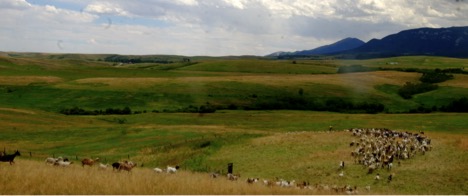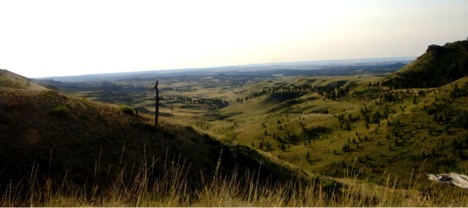Northern Plains Resource Council is a grassroots conservation group that organizes Montana citizens, farmers, and ranchers around coal, water quality, and the interconnected health of landscapes and agricultural communities. It’s unlike any other conservation organization I’ve worked with or heard of in that it was founded by ranchers having to fight coal to stay on their land. As the organization has grown and evolved over the past 40 years, ranchers have remained a driving force for Northern Plains’ environmental work.
 Northern Plains rancher moves yearlings to higher ground. This ranch subdivides large paddocks into small units with temporary fencing for higher-density rotational grazing.
Northern Plains rancher moves yearlings to higher ground. This ranch subdivides large paddocks into small units with temporary fencing for higher-density rotational grazing.
Most recently, local ranchers’ land ethic resulted into a new Northern Plains Soil Campaign. The goal of the Soil Campaign is to build resources and systems of support for these and other forward-thinking producers across Montana around “soil-building” practices. I came on with Northern Plains as a “Soil Fellow” to help lead this campaign. Over the past three months I’ve had the opportunity and pleasure to work with and get to know a network of producers across Montana. Collectively they have as strong a conservation ethic as any urban or ex-urban environmentalist I’ve ever met. They see themselves as stewards of land, water, animals, wildlife, even of climate.
 Producers like these are using small ruminants like goats and sheep in high-density grazing systems to both increase soil organic matter (sequester carbon), and control invasive weeds like leafy spurge.
Producers like these are using small ruminants like goats and sheep in high-density grazing systems to both increase soil organic matter (sequester carbon), and control invasive weeds like leafy spurge.
At the heart of the Soil Campaign is carbon. These are farmers and ranchers and asking the question how can we sequester the most possible carbon? They see themselves not only as food producers, but as climate change mitigators. They believe their animals and crops can improve landscape functions such as hydrology, productivity, and diversity. Whereas many ranchers or livestock farmers have come to call themselves “grass farmers”–they think of the focus of their work less as rearing animals, and more as growing grass– these producers are coming to think of themselves soil farmers, or “carbon ranchers.”
 In the 1990’s a major fire consumed the Charter’s Ranch. Since then the family has been working hard to sequester all that lossed carbon back into their soils for increased productivity, greater water infiltration, and to help mitigate climate change.
In the 1990’s a major fire consumed the Charter’s Ranch. Since then the family has been working hard to sequester all that lossed carbon back into their soils for increased productivity, greater water infiltration, and to help mitigate climate change.
How do we build resources for soil farmers and carbon farmers? What do such systems of support look like? As a grassroots organization, we’re trying to let farmers and ranchers tell us exactly what they need. I’ve driven across much of Montana asking ranchers and farmers what barriers they face to implementing soil-building practices, and on October 15th we hope to get them all in the same room to move this conversation forward. This will be Montana’s first “Soil Summit.” It will bring together producers from across the state to discuss soil health, carbon-sequestration and carbon payment programs, soil monitoring, and opportunities and resources for ecological farm and rangeland management.
 Eamon is organizing Northern Plains’ first Soil Summit, happening October 15th in Billings Montana.
Eamon is organizing Northern Plains’ first Soil Summit, happening October 15th in Billings Montana.
Our hope is to get farmers, ranchers, university researchers, NRCS conservationist and extension agents in the same room to synthesize and build an agenda to advance soil-practices in the state. What will follow? Some ideas already on the table include a community soil monitoring network to track individual and community progress, expanded resources and services from public agencies, state and federal policies agendas to advance this work, and a more formal coalition of producers to provide peer-to-peer support.
